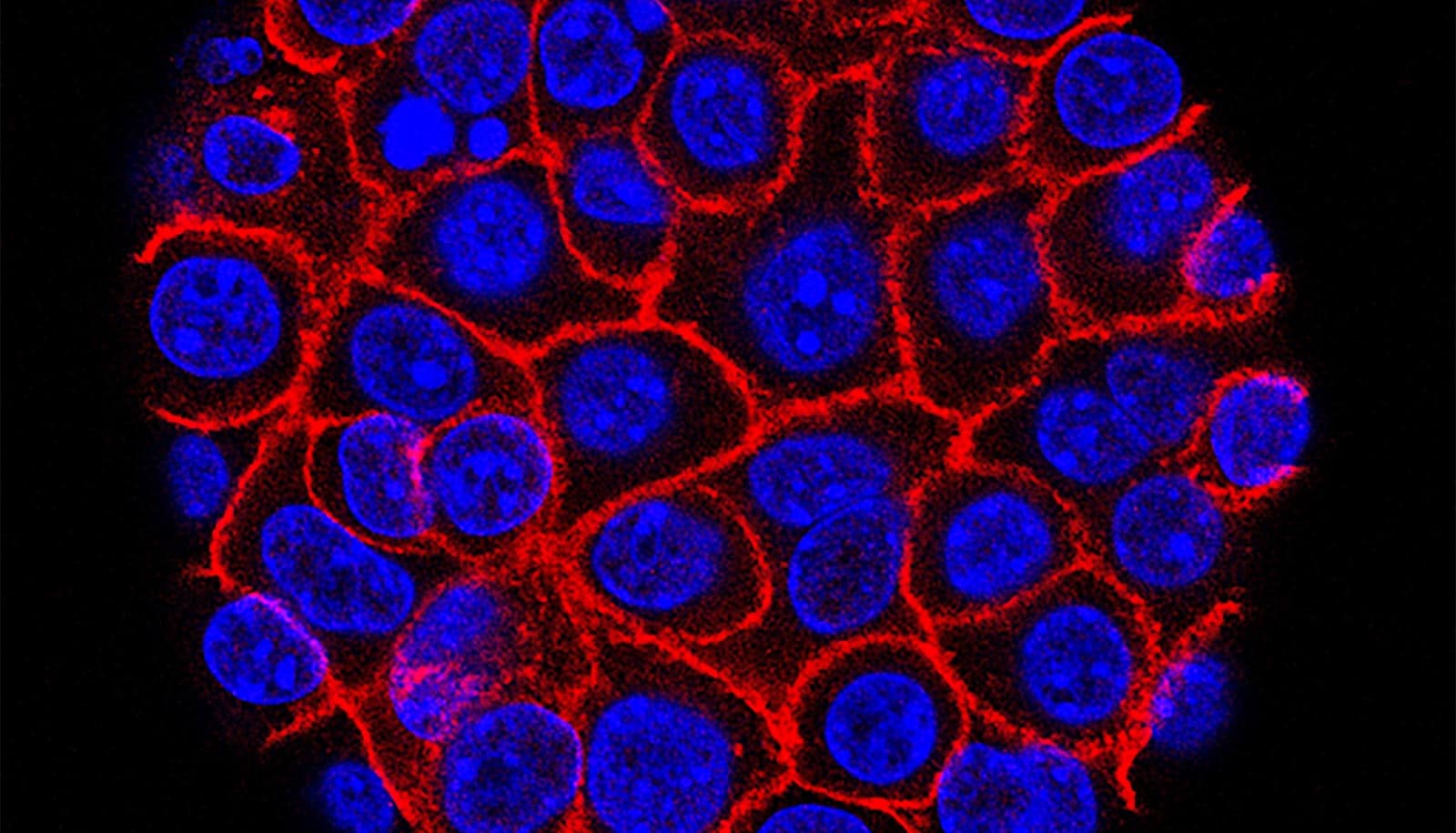
Pancreatic cancer cells (nuclei in blue) growing as a sphere encased in membranes (red). (Credit: NIH Image Gallery/Flickr )
Biomarker may reveal pancreatic cancer risk early
Newly discovered biomarkers may offer a way to predict if pancreatic cysts will turn to cancer or remain benign.
Newly identified biomarkers could help distinguish whether cysts on the pancreas are likely to develop into pancreatic cancer or remain benign.
The finding marks an important first step toward a clinical approach for classifying lesions on the pancreas that are at highest risk of becoming cancerous, potentially enabling their removal before they begin to spread.
If successful, the biomarker-based approach could address the biggest impediment to decreasing the chance of developing pancreatic cancer, which is on the rise and is notorious for silently growing before being discovered, often incidentally, during abdominal scans.
“Even when pancreas cancer is detected at its earliest stage, it almost always has shed cells throughout the body, and the cancer returns,” says Peter Allen, chief of the division of surgical oncology in the surgery department at Duke University School of Medicine.
“If the current trajectory continues, [pancreatic cancer] will become the second-leading cause of cancer death in the United States in the next few years.”
“That’s why we shifted our focus to these precancerous cysts, known as intraductal papillary mucinous neoplasms, or IPMNs,” Allen says. “Most IPMNs will never progress to pancreas cancer, but by distinguishing which ones will progress, we are creating an opportunity to prevent an incurable disease from developing.”
Allen and colleagues used a sophisticated molecular biology tool called digital spatial RNA profiling to home in on specific areas of the cyst with high- and low-grade areas of abnormal cell growth.
Previous methods to characterize IPMNs have been less precise and have not been able to identify particularly accurate markers of cancer risk. Digital spatial profiling, however, allows researchers to choose individual groups of cells for analysis.
This enabled the researchers to identify a host of genetic mutations that both fuel and potentially suppress pancreatic cancer development.
The team also identified markers for discriminating between the two leading variants of IPMN and found distinct markers for defining a third common variant that generally results in less aggressive disease.
“We found very distinct markers for high-grade cell abnormalities, as well as for slow-growing subtypes,” Allen says. “Our work now is focusing on finding it in the cyst fluid. If we can identify these unique markers in cyst fluid, it could provide the basis for a protein biopsy that would guide whether we should remove the cyst before cancer develops and spreads.”
Current diagnostic strategies—including clinical, radiographic, laboratory, endoscopic, and cytologic analysis—have an overall accuracy of approximately 60%.
“Pancreatic cancer is on the rise and, if the current trajectory continues, it will become the second-leading cause of cancer death in the United States in the next few years,” Allen says, noting it’s unknown what is driving the cancer’s increased prevalence.
Some studies suggest inflammation plays a role, he says. Allen is leading a clinical trial at Duke, that is testing whether an anti-inflammatory therapy could reduce the development of cancer in patients with IPMN.
The study in the journal Science Advances received funding support from the National Cancer Institute.
Source: Duke University
The post Biomarker may reveal pancreatic cancer risk early appeared first on Futurity .
Share this article:
This article uses material from the Futurity article, and is licenced under a CC BY-SA 4.0 International License. Images, videos and audio are available under their respective licenses.
Related Articles:
Urine test detects new or returning bladder cancer
June 9, 2021 • futurityTeam uncovers a key actor in pancreatic cancer’s spread
Feb. 12, 2024 • futurityLinks/images:
- https://www.futurity.org/gel-like-implant-pancreatic-cancer-2818532/
- https://www.futurity.org/genetic-test-pancreatic-cancer-1561492/
- https://clinicaltrials.gov/ct2/show/NCT04207944?recrs=a&cond=Pancreatic+Cancer&locn=Duke&cntry=US&state=US%3ANC&draw=2&rank=2
- https://doi.org/10.1126/sciadv.ade4582
- https://corporate.dukehealth.org/news/biomarkers-show-promise-identifying-early-risk-pancreatic-cancer
- https://www.futurity.org/pancreatic-cancer-biomarkers-2893162/
- https://www.futurity.org


